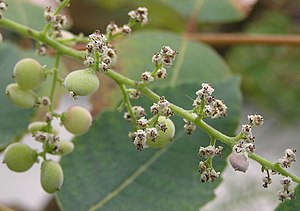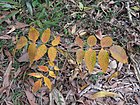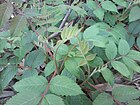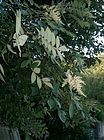Note: This is a project under development. The articles on this wiki are just being initiated and broadly incomplete. You can Help creating new pages.
Rhus chinensis
Rhus chinensis is a deciduous shrub or small tree with an open, spreading crown' it usually grows from 2 - 12 metres tall. The bole can be 6 - 18cm in diameter. The plant has an extensive root system and spreads by means of suckers, often forming thickets. The tree has a range of uses including - producing an edible fruit; having medicinal properties; a source of tannins, dye plant and source of oil. It is gathered from the wild and mainly used locally. Galls produced as a result of insect activity on the plant are widely used medicinally in east Asia, especially in polyherbal preparations, and are often traded.
Uses
Diarrhoea, Haemorrhage, Persistent cough, Spontaneous sweating, Night sweats, Bloody stool, Urorrhoea, Bloody sputum, Haemoptysis, Inflammations, Laryngitis.[1]
Parts Used
Chemical Composition
Ten compounds were obtained: β-sitosterol (1), morolic acid (2), (2S) -1-O-heptatriacontanoyl glycerol (3), α-monpalmitin (4), palmitic acid (5), gallic acid (6), methyl gallate (7), ethyl gallate (8), propyl gallate (9), and protocatechuic acid (10)[2]
Common names
| Language | Common name |
|---|---|
| Kannada | |
| Hindi | Tatri |
| Malayalam | |
| Tamil | |
| Telugu | |
| Marathi | |
| Gujarathi | |
| Punjabi | |
| Kashmiri | |
| Sanskrit | |
| English | Chinese Sumac |
Properties
Reference: Dravya - Substance, Rasa - Taste, Guna - Qualities, Veerya - Potency, Vipaka - Post-digesion effect, Karma - Pharmacological activity, Prabhava - Therepeutics.
Dravya
Rasa
Guna
Veerya
Vipaka
Karma
Prabhava
Habit
Identification
Leaf
| Kind | Shape | Feature |
|---|---|---|
Flower
| Type | Size | Color and composition | Stamen | More information |
|---|---|---|---|---|
| {{{5}}} |
Fruit
| Type | Size | Mass | Appearance | Seeds | More information |
|---|---|---|---|---|---|
Other features
List of Ayurvedic medicine in which the herb is used
Where to get the saplings
Mode of Propagation
How to plant/cultivate
Rhus chinensis is a plant of the warm temperate to tropical zones, found at elevations of 900 metres or more in Indonesia. It only has moderate cold-hardiness, tolerating short periods with temperatures down to around -8°c when it is fully dormant.[4]
Commonly seen growing in areas
Photo Gallery
References
External Links
- Ayurvedic Herbs known to be helpful to treat Diarrhoea
- Ayurvedic Herbs known to be helpful to treat Haemorrhage
- Ayurvedic Herbs known to be helpful to treat Persistent cough
- Ayurvedic Herbs known to be helpful to treat Spontaneous sweating
- Ayurvedic Herbs known to be helpful to treat Night sweats
- Ayurvedic Herbs known to be helpful to treat Bloody stool
- Ayurvedic Herbs known to be helpful to treat Urorrhoea
- Ayurvedic Herbs known to be helpful to treat Bloody sputum
- Ayurvedic Herbs known to be helpful to treat Haemoptysis
- Ayurvedic Herbs known to be helpful to treat Inflammations
- Ayurvedic Herbs known to be helpful to treat Laryngitis
- Herbs with Fruits used in medicine
- Herbs with common name in Hindi
- Herbs with common name in English
- Habit - Deciduous tree
- Index of Plants which can be propagated by Seeds
- Index of Plants which can be propagated by Cuttings of half-ripe wood
- Index of Plants which can be propagated by Root cuttings
- Index of Plants which can be propagated by Suckers
- Herbs that are commonly seen in the region of Mountain forests
- Herbs that are commonly seen in the region of Forests along streams
- Herbs that are commonly seen in the region of Thickets
- Herbs that are commonly seen in the region of Secondary forest
- Herbs






